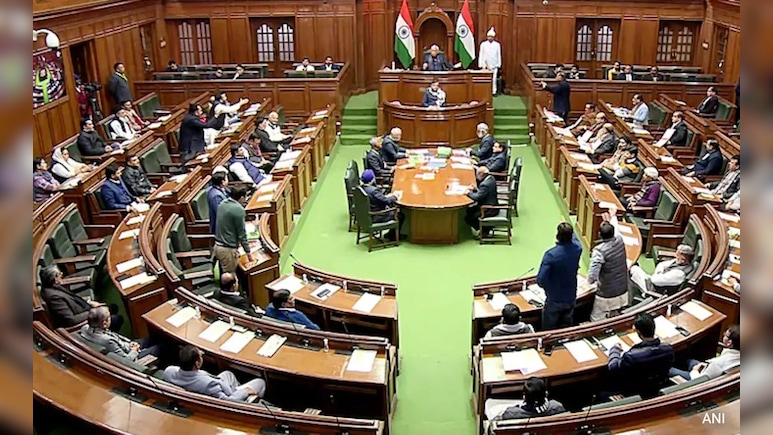
- ChatGPT was cited during a Delhi Assembly debate on a disputed colonial-era hanging room claim
- Former Speaker Ram Niwas Goel called the underground chamber a British-era gallows in 2021
- BJP challenged the claim, stating archival evidence shows it was a tiffin room with a goods lift
A routine day of proceedings in the Delhi Vidhan Sabha on Tuesday turned into a charged discussion over a controversial historical claim, with an unexpected participant entering the fray: ChatGPT.
The debate centred around a section of the Assembly premises previously referred to as a British-era "hanging chamber" by former Speaker Ram Niwas Goel in 2021, following the discovery of an underground structure. The room, located beneath the main Assembly floor at the Old Secretariat, was formally inaugurated in 2022 with a plaque that suggested it had been used for executions during the British rule.
However, BJP legislators on Tuesday challenged the claim, calling it historically inaccurate and based on misinterpretation. The discussion quickly escalated when an Aam Aadmi Party (AAP) MLA referenced ChatGPT to back the original claim, drawing a sharp response from the Speaker and Treasury bench members.
Timeline Of The Claim
In 2016, an underground tunnel-like passage was found below the Assembly building. In 2021, Mr Goel described it as part of a colonial-era escape route, and in 2022, a nearby chamber was inaugurated with a plaque marking it as a "hanging room" connected to events around the Quit India Movement.
But according to BJP MLA Abhay Verma, archival records do not support this description.
"When this building was being constructed, this place was an elevator. It was a tiffin room with a lift for transporting goods," Verma said, demanding a resolution condemning what he called a distortion of historical facts.
"Arvind Kejriwal has completely misrepresented the history of this House," he added.
AI Enters The Floor Debate
In an unusual development, AAP MLA Jarnail Singh brought up ChatGPT during the session, stating, "If you search for 'gallows in Delhi Assembly' on ChatGPT today, all the information traces back to here."
He argued that the BJP was attempting to downplay or erase historical links to the Colonial era, and that the information presented by the former government had shaped how the site is now perceived publicly, including online.
Speaker Responds
Speaker Vijender Gupta dismissed the AI reference, cautioning against the use of digital summaries as primary evidence. "Even the lies of ChatGPT are being spread. The people of the country are being misled," he said, adding that the matter had been reviewed with the help of historians and archival material.
He issued a detailed clarification during the session. "There is no tunnel beneath the Assembly - what is being referred to is ducting used for ventilation. Similar designs exist in Parliament buildings as well," he said.
Regarding the room, Gupta added, "It is a tiffin room. The wooden lift found inside was used to carry food and items, not for executions. No evidence has been found to support the presence of gallows."
Government Backs Speaker
Delhi Minister Parvesh Verma also questioned the earlier narrative. "ChatGPT says it was Ram Niwas Goel who described it as a hanging house. But the maps we found from the archives do not support this. We must respect the dignity of the House," he said.
Later, taking the reporters to tour the site in question, he said, ""When this building was being constructed, this place was an elevator. Arvind Kejriwal has completely distorted such a significant history. Today, during the Assembly session, all the facts were presented."
"The photos, maps and documents we have received prove that there was no gallows here. There was only an elevator used to move goods up and down. We will remove the gallows from here and present the true form and reality of this place," he added.
BJP MLA Ajay Mahawar added that earlier claims needed closer scrutiny, stating, "One by one, the previous government's misrepresentations are coming to light."
AAP Accuses Speaker Of Silencing Opposition
The AAP defended the earlier statements made by its leaders. Party sources said the claims were not fabricated but based on information available during renovation works and shared with the public accordingly.
Tensions rose when AAP MLA Atishi alleged that when she attempted to respond, her microphone was reportedly turned off.
Building's Past And Public Memory
The Assembly building, originally constructed in 1912, was once the seat of the Imperial Legislative Council after the capital was shifted from Kolkata to Delhi. It also housed the temporary Central Secretariat until the Parliament building was inaugurated in 1927.
Since then, the site has hosted several legislative bodies, including the Metropolitan Council (1966-1990), and has been the official seat of the Delhi Legislative Assembly since 1993.
The room in question lies beneath the semi-circular Assembly Hall. A plaque installed in 2022 links it to the Quit India Movement, and its inauguration was publicised as part of efforts to acknowledge the colonial past.
Next Steps
Speaker Gupta indicated that a review of all commemorative plaques and historical references within the Assembly premises may be initiated. No formal committee has been announced yet.
"This institution is built on truth. We must avoid misrepresentation, whether deliberate or accidental," he said, while urging all members to refrain from relying on online summaries or unverified public information in legislative matters.
Track Latest News Live on NDTV.com and get news updates from India and around the world

